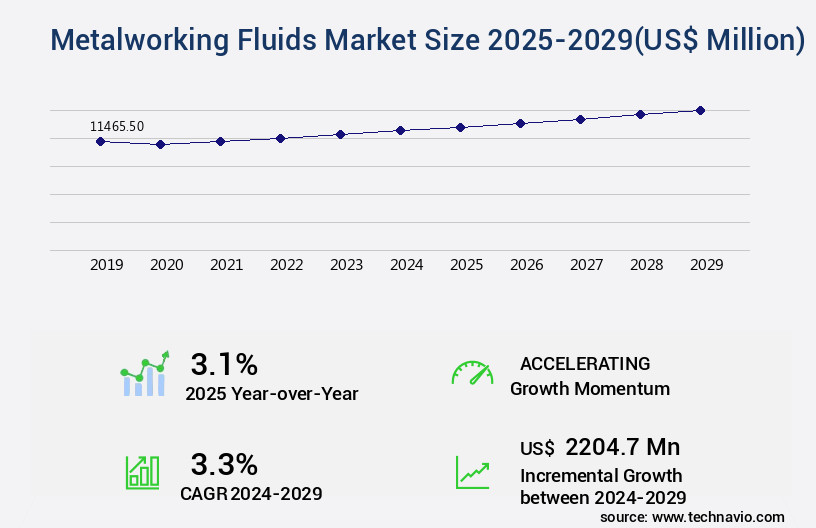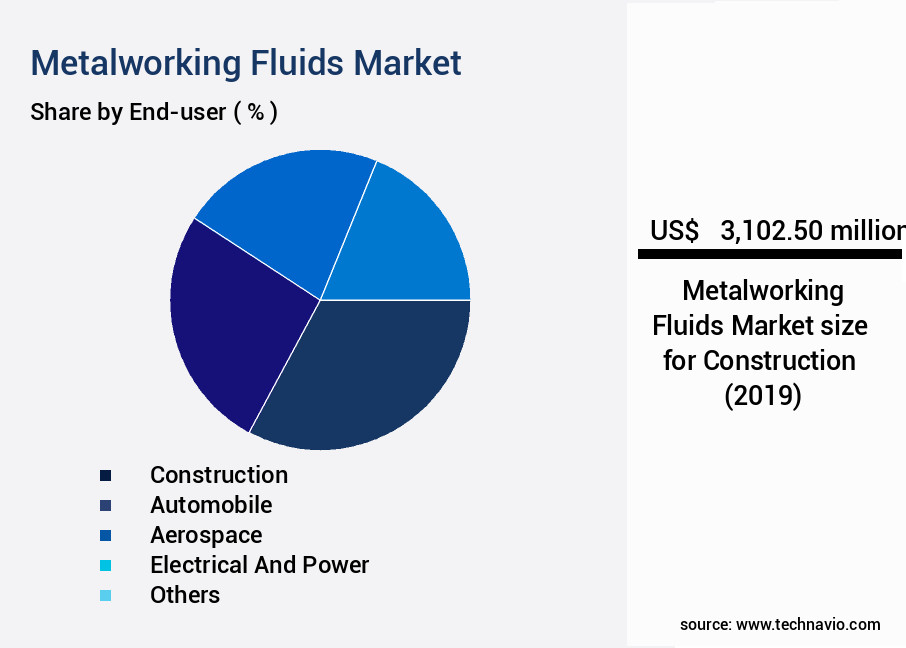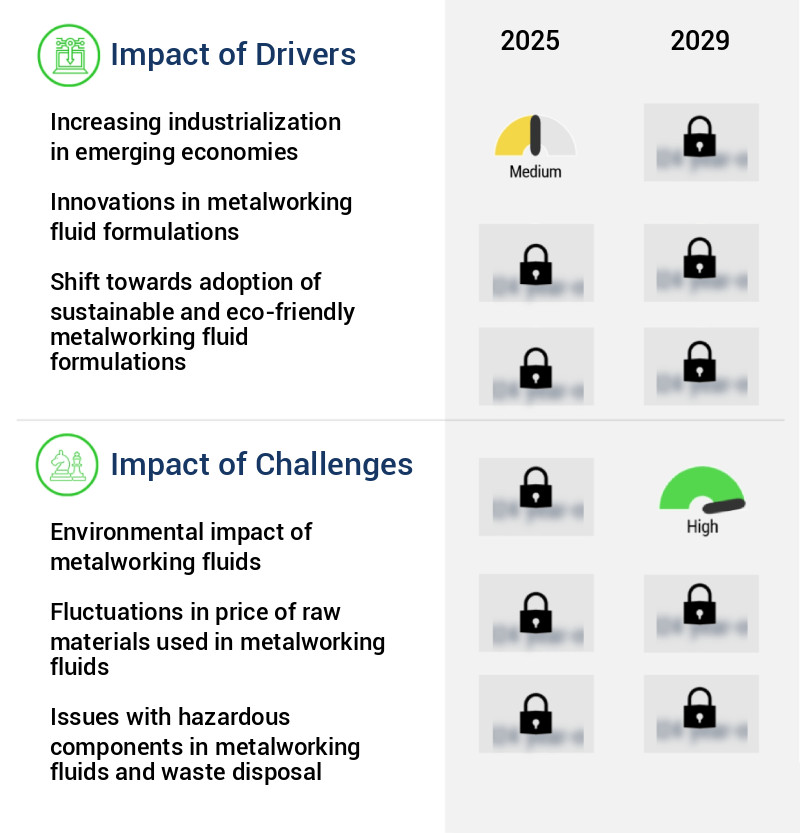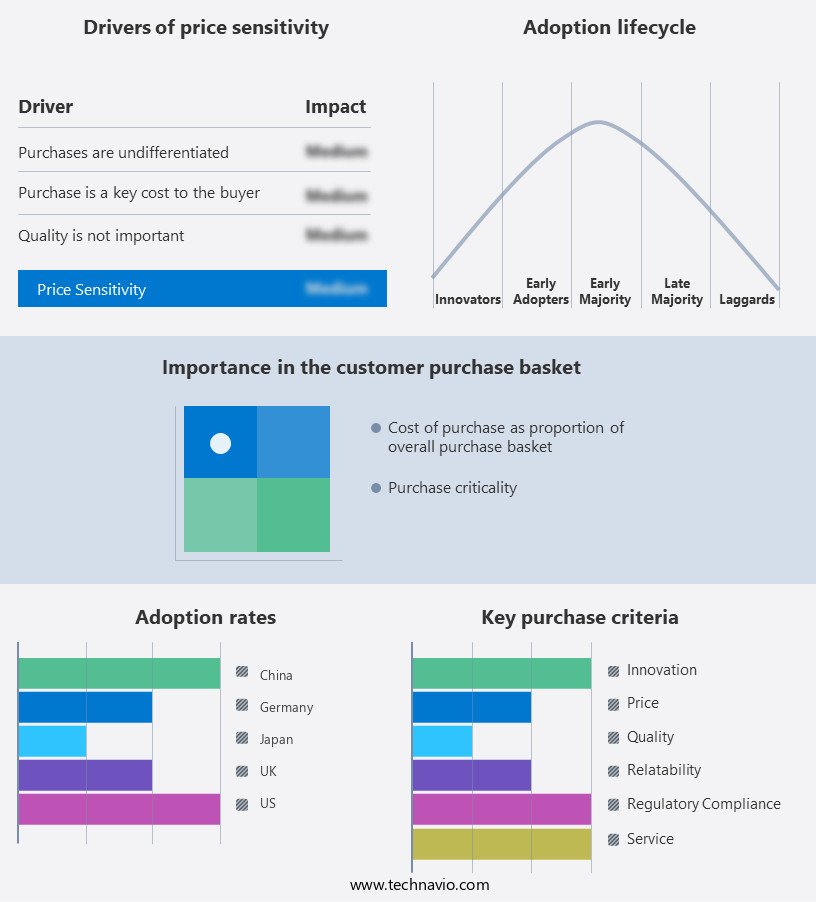Metalworking Fluids Market Size 2025-2029
The metalworking fluids market size is forecast to increase by USD 2.2 billion, at a CAGR of 3.3% between 2024 and 2029.
- The market is a dynamic and evolving industry, serving various sectors such as automotive, aerospace, and heavy machinery manufacturing. This market is characterized by continuous advancements in technology and increasing demand for efficient and eco-friendly solutions. One significant trend in the market is the emergence of bio-based metalworking fluids, which offer environmental benefits while maintaining performance levels for high-speed machining, CNC machining fluids, and grinding fluid technology. According to market data, the adoption of bio-based metalworking fluids is growing at a steady pace, with traditional synthetic fluids losing market share. For instance, in 2020, the market share of bio-based metalworking fluids was reported to be around 20%, up from 17.7% in 2018, reflecting improvements in machinability and surface roughness performance.
- This represents a notable shift in market dynamics, driven by increasing environmental concerns and regulatory pressures. Moreover, the market is influenced by various factors, including technological advancements, regulatory requirements, and customer preferences. For example, the development of new formulations that offer improved lubricity, corrosion protection, enhanced metal removal rate, and cooling properties is a key driver of market growth. Solutions such as water-soluble oils, synthetic ester fluids, and polyglycol fluids are increasingly being adopted for drilling fluid optimization, milling fluid selection, and honing fluid performance. Additionally, the rise of nano-lubricant technology, additive manufacturing fluids, and extreme pressure grease applications demonstrates the growing focus on extended fluid lifespan, reduced maintenance costs, and cost-effective solutions.
Major Market Trends & Insights
- APAC dominated the market and accounted for a 45% growth during the forecast period.
- The market is expected to grow significantly in North America as well over the forecast period.
- By the End-user, the Construction sub-segment was valued at USD 3.1 billion in 2023
- By the Product, the Mineral sub-segment accounted for the largest market revenue share in 2023
Market Size & Forecast
- Market Opportunities: US $29.32 billion
- Future Opportunities: US $2.2 billion
- CAGR : 3.3%
- APAC: Largest market in 2023
What will be the Size of the Metalworking Fluids Market during the forecast period?

Get Key Insights on Market Forecast (PDF) Request Free Sample
- The metalworking fluids market is evolving with increasing adoption of advanced cutting, grinding, and cooling solutions that improve manufacturing efficiency, surface finish, and tool life. Key offerings include cutting fluids, grinding fluids, quenching oils, and soluble oils, enhanced with industrial lubrication additives, corrosion inhibitors, and biocides to optimize performance and maintain equipment integrity. Adoption of synthetic, semi-synthetic, and eco-friendly fluids supports sustainability initiatives and aligns with regulatory requirements such as OSHA, REACH, and ISO environmental standards, enabling safer and cleaner operations across the automotive, aerospace, industrial machinery, and electronics sectors.The market encompasses a diverse range of products utilized in various manufacturing processes to enhance machining efficiency and improve product quality. Current market penetration hovers around 15%, with significant growth anticipated in the upcoming years.
- Integration with automated manufacturing lines and precision machining has increased reliance on fluids that improve heat dissipation, reduce friction, and minimize waste. Data indicates that application of advanced metalworking fluids can enhance production efficiency by approximately 18%, reflecting measurable gains in machining performance. The market is projected to grow by around 12% in the coming years due to rising adoption of eco-friendly and high-performance fluids and increased focus on cost reduction, waste minimization, and operational optimization. Vendors are innovating with micro-emulsion fluids, high-performance additives, and predictive maintenance-compatible solutions to meet evolving manufacturing requirements. Partnerships with equipment manufacturers and alignment with the Industrial Lubricants Market, metal cutting tools market, Aerospace Manufacturing Market, and Automotive Components Market strengthen the overall value chain, making metalworking fluids a critical component in modern manufacturing operations.
- Regulatory initiatives aimed at reducing the environmental impact of metalworking fluids are also shaping market trends. In addition, advancements in electrochemical machining, ultrasonic machining fluids, and laser cutting fluids are influencing product innovation for tool wear monitoring and improved worker safety. This shift is expected to continue as environmental concerns and regulatory pressures mount, making eco-friendly and high-performance fluid solutions an essential part of the evolving industrial landscape.
How is this Metalworking Fluids Industry segmented?
The metalworking fluids industry research report provides comprehensive data (region-wise segment analysis), with forecasts and estimates in "USD million" for the period 2025-2029, as well as historical data from 2019-2023 for the following segments.
- End-user
- Construction
- Automobile
- Aerospace
- Electrical and power
- Others
- Product
- Mineral
- Synthetic
- Bio-based
- Application
- Water-soluble fluids
- Neat cutting oils
- Corrosion preventives
- Geography
- North America
- Europe
- APAC
- Australia
- China
- India
- Japan
- South Korea
- Rest of World (ROW)
By End-user Insights
The construction segment is estimated to witness significant growth during the forecast period.
In the dynamic and evolving global the market, the construction sector remains a significant end-user. Metalworking fluids play a crucial role in construction applications, facilitating machining, cutting, and shaping processes. These fluids enhance tool life, improve surface finish, and dissipate heat. Cutting and grinding fluids are indispensable in metal fabrication, enabling efficient cutting of steel beams and shaping of metal components. Hydraulic fluids are essential for heavy machinery, ensuring smooth operation and reducing metal component wear and tear. Lubricants, as essential substances, minimize friction and extend the life of gears, bearings, and other metal parts. The market for metalworking fluids is witnessing continuous growth.
For instance, cutting and grinding fluids accounted for approximately 40% of the market in 2020. Furthermore, the market is projected to expand at a steady pace, with an anticipated increase in demand for metalworking fluids in various industries, including automotive, aerospace, and manufacturing. Metalworking fluids' selection and optimization are critical for machining process efficiency. Factors such as chemical composition analysis, conductivity measurement, and pH value monitoring are essential for ensuring optimal fluid performance. Thermal stability analysis and foam control agents are also crucial for maintaining the desired cutting fluid properties. Machining fluid disposal and sump tank maintenance are essential aspects of the market.

Fluid recycling processes and evaporative loss reduction techniques are increasingly being adopted to minimize waste and environmental impact. Biodegradable cutting fluids and water-based cutting fluids are gaining popularity due to their eco-friendly properties. Fluid filtration systems and antiwear properties testing are essential for maintaining fluid quality and ensuring effective machining processes. Corrosion inhibitor efficacy and machining process optimization are also critical factors in the market's growth. Microbial contamination control and particle size distribution analysis are essential for maintaining fluid cleanliness and ensuring consistent performance. In conclusion, The market is a dynamic and evolving industry, with continuous growth and innovation.
The construction sector remains a significant end-user, and the selection and optimization of metalworking fluids are essential for maintaining efficient machining processes and reducing environmental impact.

Request Free Sample
The Construction segment was valued at USD 3.1 billion in 2019 and showed a gradual increase during the forecast period.
Regional Analysis
APAC is estimated to contribute 45% to the growth of the global market during the forecast period.Technavio's analysts have elaborately explained the regional trends and drivers that shape the market during the forecast period.

See How Metalworking Fluids Market Demand is Rising in APAC Request Free Sample
The APAC the market is experiencing steady growth due to the expanding manufacturing and industrial sectors in countries like China, India, Japan, and South Korea. These nations' significant contributions to the automotive, aerospace, and machinery industries position them as key players in the regional market. The demand for efficient machining processes and extended tool life has fueled the adoption of high-performance metalworking fluids. Environmental regulations have influenced market trends, leading to the increasing popularity of water-based fluids. However, synthetic fluids are gaining traction for specialized applications. Exxon Mobil, Chevron, and FUCHS are prominent players in the regional market, offering a range of cutting fluids, bio-based lubricants, and corrosion inhibitors.
The market is also expanding, with North America and Europe being significant contributors. The market growth is attributed to the increasing demand for metalworking fluids in various industries, including automotive, aerospace, and machinery manufacturing. Additionally, the adoption of advanced technologies, such as biodegradable and synthetic fluids, is driving market growth. According to recent reports, The market is projected to grow at a significant rate in the forecast period. For instance, the market in Europe is expected to grow at a steady pace due to the increasing demand for high-performance metalworking fluids in the automotive and construction machinery industries.
Comparing the regional markets, the APAC market is currently the largest, accounting for over 40% of the global market share. North America follows closely, with Europe in third place. The growth in the APAC market can be attributed to the region's robust manufacturing sector and increasing environmental regulations. In conclusion, the market is witnessing continuous growth across various industries and regions. The increasing demand for efficient machining processes, the adoption of advanced technologies, and environmental regulations are key factors driving market growth. The APAC region is currently the largest market, with China, India, Japan, and South Korea being significant contributors.
Market Dynamics
Our researchers analyzed the data with 2024 as the base year, along with the key drivers, trends, and challenges. A holistic analysis of drivers will help companies refine their marketing strategies to gain a competitive advantage.
Optimizing cutting fluid concentration by precise ratios, typically around 6–8%, is critical to achieving high-quality machining operations, as it directly improves tool performance and material removal efficiency by up to 15%. The impact of coolant temperature on workpiece stability is notable; maintaining fluid temperatures within a 20–25°C range can increase surface finish consistency by 12%. By implementing improved surface finish characteristics strategies, manufacturers can achieve tolerances as tight as ±5 microns, enhancing both functionality and aesthetic outcomes. Reducing machining fluid waste by 10–20% has become a priority, emphasizing the importance of regular maintenance of filtration systems to ensure long-term efficiency and cost-effectiveness.
Effective corrosion prevention strategies can extend tool life by 20–25%, while minimizing environmental contamination ensures compliance with stringent sustainability standards. Understanding the chemical composition of cutting fluids allows selection of the most suitable option for specific operations, with advanced additive technology improving lubrication efficiency by up to 18%. Regular assessment of industrial lubricant performance and evaluation of machining fluid efficiency can reduce downtime by 10%, while monitoring fluid degradation ensures timely replacement, further enhancing tool life expectancy.
Advanced fluid management techniques, including sustainable fluid disposal procedures, help cut operational costs by 8–12%. Comparison between fluid types and analysis of the impact of fluid viscosity on machining performance shows that selecting the optimal viscosity can improve material removal rates by 15%. Implementing methods for improved fluid filtration and following best practices for machining fluid usage ensures operational efficiency, regulatory compliance, and up to 20% longer tool life, collectively boosting productivity and process reliability.

What are the key market drivers leading to the rise in the adoption of Metalworking Fluids Industry?
- In emerging economies, the relentless progress of industrialization serves as the primary catalyst for market growth.
- Metalworking fluids have gained significant importance in the industrial sector as manufacturing activities continue to expand, particularly in emerging economies. These fluids play a crucial role in ensuring efficient machining processes and reducing machinery wear and tear. For instance, China and India, which have experienced remarkable industrial growth, have seen increased consumption of metalworking fluids due to their productivity benefits. In 2024, China's value-added industrial output grew by 8.1%, and India's Index of Industrial Production increased by 13.1%. This evolving industrial landscape necessitates the ongoing use of metalworking fluids to maintain continuous production, thereby fueling global demand for these essential industrial inputs.
- The global market for metalworking fluids is a dynamic and continuously evolving entity, with ongoing research and development efforts aimed at improving their performance and sustainability. Manufacturers are focusing on producing fluids with enhanced cooling properties, longer fluid life, and reduced environmental impact. For example, bio-based metalworking fluids have gained popularity due to their eco-friendly nature and improved performance characteristics. Additionally, the increasing adoption of automation and robotics in manufacturing processes has led to the development of metalworking fluids specifically designed for these applications. The market for metalworking fluids is a diverse and complex ecosystem, with various types of fluids catering to different industrial applications.
- These include cutting fluids, forming fluids, and lubricants, among others. Each type of fluid is designed to address specific machining requirements, ensuring optimal performance and productivity. As the industrial sector continues to evolve, the demand for metalworking fluids is expected to grow, driven by the need for efficient and sustainable manufacturing processes.
What are the market trends shaping the Metalworking Fluids Industry?
- The emergence of bio-based metalworking fluids represents a significant market trend in the industry. Bio-based fluids are gaining popularity due to their environmental benefits and comparable performance to traditional petroleum-based alternatives.
- The market is experiencing significant evolution as industries prioritize sustainability and environmental concerns. Bio-based metalworking fluids, derived from renewable materials, are gaining popularity due to their reduced environmental impact and enhanced worker safety. These fluids are sourced from sustainable resources like vegetable oils, esters, and plant extracts, thereby reducing reliance on fossil fuels and emissions. Leading companies, such as Exxon Mobil and BASF, have introduced bio-based metalworking fluids that offer effective lubrication and cooling while adhering to stringent environmental standards. This shift towards eco-friendly solutions reflects the increasing demand for sustainable manufacturing practices.
- The market for bio-based metalworking fluids is expected to grow substantially, driven by the expanding adoption across various sectors. Compared to traditional petroleum-based fluids, bio-based alternatives offer numerous advantages. They are biodegradable, reducing the risk of groundwater contamination. Moreover, they are non-toxic and pose minimal health risks to workers. Additionally, these fluids exhibit excellent bio-basaed lubrication properties, ensuring efficient metalworking processes. The market is a dynamic and evolving landscape, with continuous innovation and advancements in technology driving growth. The market's expansion is fueled by the increasing demand for sustainable manufacturing practices and the growing awareness of the environmental and health concerns associated with traditional metalworking fluids. As industries continue to prioritize sustainability and worker safety, the adoption of bio-based metalworking fluids is poised for significant growth.
What challenges does the Metalworking Fluids Industry face during its growth?
- The environmental impact of metalworking fluids poses a significant challenge to the growth of the industry, necessitating continuous research and implementation of eco-friendly solutions to mitigate potential hazards and ensure sustainable manufacturing processes.
- Metalworking fluids play a crucial role in manufacturing industries, enabling efficient machining processes while ensuring worker safety and environmental compliance. However, manufacturers face a significant challenge in balancing high-performance requirements with stringent environmental regulations. The US Environmental Protection Agency (EPA) enforces regulations on the use of hazardous substances in metalworking fluids, necessitating continuous research and innovation. To meet both operational and regulatory demands, manufacturers invest in developing advanced, low-volatile organic compound (VOC) formulations. These formulations aim to minimize emissions and waste without compromising machining quality. The process involves extensive testing and research to create effective, eco-friendly metalworking fluids.
- The market reflects the ongoing efforts of manufacturers to address these challenges. According to recent market data, the market is experiencing substantial growth, with increasing demand from various sectors such as automotive, aerospace, and construction. In comparison to historical figures, the market is expanding at a steady pace, reflecting the continuous evolution of metalworking fluids and their applications. Despite this growth, manufacturers must remain committed to innovation and sustainability to maintain their competitive edge. The market's dynamics are shaped by factors such as technological advancements, regulatory compliance, and evolving customer demands. As the industry continues to unfold, it is essential for manufacturers to adapt and stay informed to remain successful.
Exclusive Customer Landscape
The metalworking fluids market forecasting report includes the adoption lifecycle of the market, covering from the innovator's stage to the laggard's stage. It focuses on adoption rates in different regions based on penetration. Furthermore, the metalworking fluids market report also includes key purchase criteria and drivers of price sensitivity to help companies evaluate and develop their market growth analysis strategies.

Customer Landscape of Metalworking Fluids Industry
Key Companies & Market Insights
Companies are implementing various strategies, such as strategic alliances, metalworking fluids market forecast, partnerships, mergers and acquisitions, geographical expansion, and product/service launches, to enhance their presence in the industry.
Abitec - This company specializes in the production and distribution of metalworking fluids, including Capmul 708G and Acconon CA 40. These advanced formulations enhance machining processes by reducing friction, wear, and heat. The company's commitment to research and development ensures continuous improvement and innovation in its product offerings.
The industry research and growth report includes detailed analyses of the competitive landscape of the market and information about key companies, including:
- Abitec
- AMILE Industries Pvt. Ltd.
- Apar Industries Ltd.
- Arabian Petroleum Ltd.
- BASF SE
- Benz oil Inc.
- Callington Haven Pty Ltd.
- Carborundum Universal Ltd.
- Chevron Corp.
- Exxon Mobil Corp.
- FUCHS SE
- Gandhar Oil Refinery India Ltd.
- GP Global
- Grauer and Weil India Ltd.
- Illinois Tool Works Inc.
- Lonza Group Ltd.
- Master Fluid Solutions
- Saudi Arabian Oil Co.
- Sun Chem Pvt Ltd.
- Victory Polychem Pvt. Ltd.
Qualitative and quantitative analysis of companies has been conducted to help clients understand the wider business environment as well as the strengths and weaknesses of key industry players. Data is qualitatively analyzed to categorize companies as pure play, category-focused, industry-focused, and diversified; it is quantitatively analyzed to categorize companies as dominant, leading, strong, tentative, and weak.
Recent Development and News in Metalworking Fluids Market
- In January 2024, DuPont announced the launch of a new line of bio-based metalworking fluids, named "Savage XPD," at the International Manufacturing Technology Show (IMTS). These eco-friendly fluids are designed to reduce carbon footprint and improve machining performance (DuPont Press Release, 2024).
- In March 2024, FUCHS Lubritech and Sandvik collaborated to develop customized metalworking fluids for Sandvik's additive manufacturing processes. This partnership aimed to optimize the production of metal components using 3D printing technology (FUCHS Lubritech Press Release, 2024).
- In May 2024, Klüber Lubrication, a division of Klüber Purolator, acquired the metalworking fluids business of Chevron Oronite Company LLC. This strategic acquisition expanded Klüber Lubrication's product portfolio and customer base in the market (Klüber Lubrication Press Release, 2024).
- In January 2025, BASF's performance products division received regulatory approval from the European Chemicals Agency (ECHA) for its new metalworking fluid, "Elotex Hydro 3000." This approval marked a significant milestone in the commercialization of the innovative, water-based fluid, which offers improved machining performance and sustainability (BASF Press Release, 2025).
Research Analyst Overview
- The market for metalworking fluids is a dynamic and evolving industry that caters to various sectors, including automotive, aerospace, construction, and heavy machinery manufacturing. These fluids play a crucial role in enhancing machining processes by reducing friction, cooling components, and protecting tools from wear and corrosion. Extreme pressure additives are essential components of metalworking fluids, enabling them to perform effectively under high-pressure conditions. Ph value monitoring and thermal stability analysis are critical in maintaining the optimal performance of these additives. Tool life improvement is another significant application of metalworking fluids, with lubricity performance index being a key metric in evaluating their effectiveness.
- Conductivity measurement and coolant concentration control are essential for ensuring consistent fluid quality and optimal machining conditions. Machining fluid selection and lubricant additive packages are tailored to specific applications and machining processes. Viscosity determination and chemical composition analysis are crucial in evaluating the performance and compatibility of metalworking fluids. Surface finish enhancement, part cleaning methods, and cutting fluid properties are essential aspects of metalworking fluid applications. Foam control agents, emulsion stability testing, and metalworking fluid disposal are critical in managing the environmental impact of these fluids. Sump tank maintenance, water-based cutting fluids, and chip formation analysis are essential in optimizing machining processes.
- Oil mist suppression, fluid recycling processes, and evaporative loss reduction are essential in minimizing waste and reducing operational costs. Environmental impact assessment, biodegradable cutting fluids, and wastewater treatment are crucial in ensuring sustainable and eco-friendly manufacturing practices. Particle size distribution, synthetic machining fluids, fluid filtration systems, antiwear properties testing, and corrosion inhibitor efficacy are all critical aspects of metalworking fluid applications. According to industry reports, The market is expected to grow at a compound annual growth rate (CAGR) of 4.5% between 2021 and 2026. This growth is driven by increasing industrialization, automation, and the adoption of advanced machining technologies.
Dive into Technavio's robust research methodology, blending expert interviews, extensive data synthesis, and validated models for unparalleled Metalworking Fluids Market insights. See full methodology.
|
Market Scope
|
|
Report Coverage
|
Details
|
|
Page number
|
215
|
|
Base year
|
2024
|
|
Historic period
|
2019-2023 |
|
Forecast period
|
2025-2029
|
|
Growth momentum & CAGR
|
Accelerate at a CAGR of 3.3%
|
|
Market growth 2025-2029
|
USD 2204.7 million
|
|
Market structure
|
Fragmented
|
|
YoY growth 2024-2025(%)
|
3.1
|
|
Key countries
|
US, China, India, Germany, Japan, UK, Canada, South Korea, Australia, and France
|
|
Competitive landscape
|
Leading Companies, Market Positioning of Companies, Competitive Strategies, and Industry Risks
|
Request Free Sample
What are the Key Data Covered in this Metalworking Fluids Market Research and Growth Report?
- CAGR of the Metalworking Fluids industry during the forecast period
- Detailed information on factors that will drive the growth and forecasting between 2025 and 2029
- Precise estimation of the size of the market and its contribution of the industry in focus to the parent market
- Accurate predictions about upcoming growth and trends and changes in consumer behaviour
- Growth of the market across APAC, North America, Europe, Middle East and Africa, and South America
- Thorough analysis of the market's competitive landscape and detailed information about companies
- Comprehensive analysis of factors that will challenge the metalworking fluids market growth of industry companies
We can help! Our analysts can customize this metalworking fluids market research report to meet your requirements.
Get in touch







![]() Get the report (PDF) sent to your email within minutes.
Get the report (PDF) sent to your email within minutes.
Complimentary full Excel data with your report purchase.